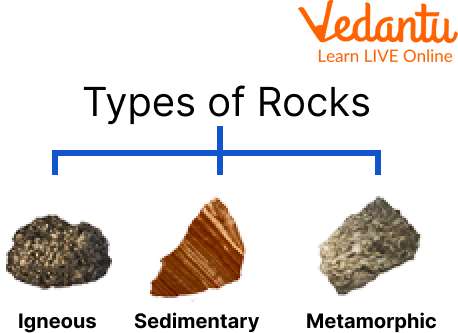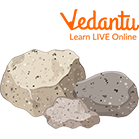




Overview of Igneous Rocks
Natural rock formation occurs when microscopic grains of various minerals are squeezed by external pressure. Different types of rocks form via different processes. The buildup or deposition of mineral or organic particles on the surface of the Earth creates sedimentary rocks. Metamorphic rocks are created when watery hot fluids are subjected to high heat and pressure. Igneous rocks are created when lava cools and solidifies. Let's explore the development of igneous rocks and some interesting information on igneous rocks information in detail in this article.
What are Rocks?
The qualities of all the mineral traces combine to form rocks, which are mineral aggregates. Any particular arrangement of chemical composition, mineralogy, grain size, texture, or other distinctive qualities can be used to classify different types of rocks. Every significant form of rock also has a different classification system. Rocks come in a variety of varieties in the natural world.
Natural rocks are rarely encountered with such basic features, and they typically display some fluctuation in the set of attributes as the measurement scale shifts.
Types of Rocks
There are three types of rocks:
Igneous Rocks are formed as magma cools and solidifies below the Earth's surface. For example, granite, basalt, sandstone and limestone.
Sedimentary Rocks are formed when mineral-rich and organic-rich sediments are deposited by water, wind, or ice. Metamorphic Rocks: They are a type of rock that forms from the merging, crushing and heating preexisting rocks. For example, gneiss and marble.

Types of Rocks
Out of these three, we will focus on Igneous Rocks.
What are Igneous Rocks?
According to the definitions, igneous rocks are rocks created when molten rock, or rock that has been liquefied by extreme heat and pressure, cools to a solid condition. The molten rock known as lava flows from cracks or vents at volcanic centres (when cooled, they form rocks such as basalt, rhyolite, or obsidian). Pyroclastic deposits are collections of broken rock ejected during volcanic eruptions, such as ash, bombs, tuffs, and volcanic breccias. They are referred to as primary rocks since igneous rocks are created from magma and start the rock cycle.

Igneous Rocks
Rocks that are igneous can be recognised by their texture, density, colour, and mineral makeup. Its texture is influenced by the rock's size, form, cooling and solidification process, and crystallinity distribution.
Igneous Rock Examples
Specifications of Igneous Rocks
The specifications of Igneous Rocks are as follows:
There are no fossil deposits in igneous rock types. If there are any fossils present deep inside the crust, they are destroyed when these rocks erupt from the Earth's surface because of the extreme heat they generate.
The majority of igneous formations have several mineral deposits.
They can be gritty or glassy.
Normally, they don't react with acids.
The mineral deposits come in the shape of different-sized patches.
Types of Igneous Rock
According to the lava they cool from, igneous rocks can have varying compositions and appearances depending on the cooling conditions. Extrusive and intrusive rocks are the two primary subcategories of igneous rocks.
Intrusive Igneous Rock
Intrusive igneous rocks form huge crystals as the earth progressively cools and crystallises beneath the surface. Intrusive igneous rocks include pegmatite, granite, and diorite, for instance.
Extrusive Igneous Rock
Extrusive igneous rocks erupt onto the surface and immediately cool, forming tiny crystals. A few rocks cool so quickly that they turn into an amorphous glass. Some examples of extrusive igneous rock are basalt, tuff, and pumice.
Facts About Igneous Rocks
Observe fascinating igneous rock facts. Discover intriguing details and various illustrations that help define igneous rocks and highlight how they differ from other types of rocks.
Magma cools and solidifies, either above or below the Earth's surface, to form igneous rock.
During volcanic eruptions, magma can be driven into rocks or forced to the surface as lava.
Magma is made up of the atoms and molecules of melted minerals.
As the lava cools, these atoms and molecules rearrange themselves into mineral grains, which coalesce to form rock.
Igneous rocks come in approximately 700 different varieties.
Basalt, granite, pumice, obsidian, tuff, diorite, gabbro, and andesite are igneous rocks.
Granulite is a metamorphic rock formed when basalt is exposed to intense heat and pressure over time (metamorphism).
Granite is a typical rock with at least 25% quartz occasionally utilised in building due to its strength.
When molten rock is suddenly thrown out of a volcano, bubbles occur as the rock rapidly loses pressure and cools simultaneously. This unique, light rock is called pumice.
Obsidian is a volcanic glass that crystallises swiftly and spontaneously; because of its potentially razor-sharp edges, it can be used as an arrowhead or cutting instrument.
A rock called tuff is created from volcanic ash.
About 95% of the Earth's crust's upper layer is formed of igneous rock.
Summary
In this article, we learned that igneous rocks, which can include a variety of crystalline or glassy noncrystalline rocks, are created when molten earth material cools and solidifies (magma). One of the three main kinds of rocks is igneous rocks, the other being metamorphic and sedimentary rocks. Most igneous rocks are composed of quartz, feldspar, pyroxenes, amphiboles, micas, olivines, nepheline, leucite, and apatite, even though their compositions vary greatly. Rocks can be characterised as either extrusive or intrusive. We hope you enjoyed reading this article. In case of any other doubts, feel free to ask in the comments.
FAQs on Igneous Rocks
1. What are igneous rocks and can you give some common examples?
Igneous rocks are one of the three main rock types, formed through the cooling and solidification of molten rock material called magma or lava. When this molten rock cools down, it crystallises and forms a solid rock. Common examples of igneous rocks include granite, which is often used for kitchen countertops, and basalt, which makes up most of the ocean floor.
2. What is the difference between intrusive and extrusive igneous rocks?
The main difference lies in where the molten rock cools.
- Intrusive igneous rocks are formed when magma cools and solidifies beneath the Earth's surface. This slow cooling process allows large crystals to form, giving the rock a coarse-grained texture. A perfect example is granite.
- Extrusive igneous rocks are formed when lava erupts onto the Earth's surface and cools quickly. This rapid cooling results in very small crystals, creating a fine-grained texture. Basalt and obsidian are common examples.
3. How are igneous rocks formed?
Igneous rocks are formed from the intense heat within the Earth's core, which melts rock into a hot, liquid substance known as magma. When this magma rises towards the surface, it begins to cool and crystallise. If it solidifies beneath the surface, it forms intrusive rocks. If it erupts from a volcano as lava and solidifies on the surface, it forms extrusive rocks. The entire process is a key part of the rock cycle.
4. What are the main characteristics of igneous rocks?
Igneous rocks are typically identified by the following characteristics:
- They are crystalline in nature, meaning their atoms are arranged in a highly ordered structure.
- They do not contain any fossils, as the intense heat of the magma would destroy any organic remains.
- They are generally very hard and resistant to erosion.
- They can be either coarse-grained (like granite) or fine-grained (like basalt), depending on how quickly they cooled.
5. Why are igneous rocks often called 'primary' or 'parent' rocks?
Igneous rocks are called 'primary' or 'parent' rocks because they are the first rocks to form in the rock cycle. They originate directly from the cooling of molten magma or lava from the Earth's interior. All other rock types, including sedimentary and metamorphic rocks, are ultimately formed from the weathering, erosion, or transformation of these original igneous rocks.
6. How does the cooling speed of magma or lava affect the appearance of an igneous rock?
The cooling speed is the most critical factor determining an igneous rock's texture. When magma cools slowly deep within the Earth, it gives mineral crystals a long time to grow, resulting in a coarse-grained rock like granite where you can see the individual crystals. Conversely, when lava cools rapidly on the surface after a volcanic eruption, there is little to no time for crystals to form, leading to a fine-grained rock like basalt or a glassy rock like obsidian.
7. How are igneous rocks like granite and pumice used in our daily lives?
Igneous rocks have many practical uses due to their hardness and durability. Granite is widely used in construction for making buildings, monuments, and paving stones, as well as for kitchen countertops because of its strength and aesthetic appeal. Pumice, a very light and porous igneous rock, is used as an abrasive in cleaning products, in lightweight concrete, and as a popular exfoliating stone in personal care.
8. How can you distinguish an igneous rock from a sedimentary rock?
You can distinguish them based on their formation and appearance. Igneous rocks are formed from cooled molten rock and have an interlocking crystalline texture. They lack layers and fossils. In contrast, sedimentary rocks are formed from the compaction of sediments (like sand, mud, or pebbles) over millions of years. They often have visible layers or strata and may contain fossils of ancient plants and animals trapped within these layers.





















